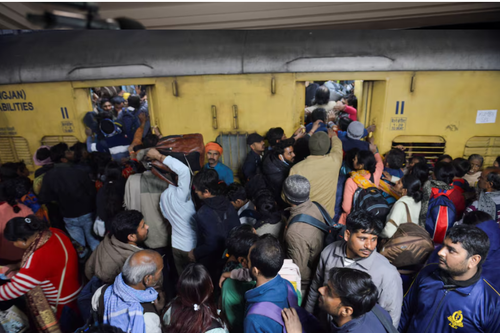Rahul Gandhi on Railway Chaos: Are We Ignoring the Silent Saviors?

The echo of hurried footsteps, the cacophony of announcements, the silent plea for space – railway stations in India are often a microcosm of controlled chaos. But what happens when that control slips? What happens when the rush turns into a stampede?
Rahul Gandhi recently brought these concerns to the forefront, not just through a politician's usual statement, but through direct interaction. He met with the coolies (porters) at New Delhi Railway Station, those unsung heroes who navigate the crowds daily, often risking their own safety to help others.
Gandhi’s expression of "deep concern" followed the tragic February 15th incident. But is concern enough? Or do we need concrete action to prevent such horrors from recurring?

The Congress leader didn’t just offer condolences. He listened. He heard the coolies' accounts of the chaos, their struggles to rescue passengers amidst the surge, and their own daily battles against poverty. They spoke of having to choose between sending money home and affording a single meal.
"Our Porter brothers are forced to live in such hardship. They risk their lives to help others, yet their voices remain unheard," Gandhi remarked. The question is, why are their voices unheard? Are we so caught up in the grand narratives of progress that we overlook the plight of those who keep the wheels turning, literally?
Gandhi vowed to take up their cause, promising to fight for their rights at the "highest level." He even shared a video on his YouTube channel, urging people to share suggestions on the 'Awaaz Bharat Ki' portal to improve crowd management and strengthen security.
However, according to sources, the 'Awaaz Bharat Ki' portal, while intended to gather public input, has faced challenges in effectively translating suggestions into actionable policies. Early reports indicate that less than 10% of suggestions have been implemented, raising questions about its overall effectiveness.
The February 15th stampede at New Delhi Railway Station claimed 18 lives, including five children. A horrifying reminder of the potential consequences of inadequate safety measures. Was it simply an unfortunate event, or a symptom of a larger systemic problem? Are our railway stations equipped to handle the sheer volume of passengers they serve? The Indian Railways aims to prevent further tragedies through AI-powered monitoring and holding areas.

Gandhi's appeal for public participation is crucial. Crowd management isn't just the responsibility of the authorities; it requires collective awareness and action. But how do we ensure that this participation translates into meaningful change? One key step is prioritizing the voices of those most affected, such as the railway porters who navigate the crowds daily.
Here are some key questions to ponder:
- How can we better equip railway staff to handle crowd surges?
- What technological solutions can be implemented to monitor and manage passenger flow?
- How do we address the underlying issues of poverty and lack of opportunity that force many to risk their lives as porters?
New Delhi Police has taken immediate action to manage the situation following the February 15 incident. Enhanced security measures, barricades, and increased patrolling have been implemented. To prevent overcrowding, access control measures are in place, allowing only passengers with valid tickets on platforms and foot overbridges. A designated waiting area has also been set up outside the station to manage early arrivals.
Perhaps, the most important question is: Will we, as a society, finally start listening to the voices of the silent saviors who keep our railways moving? Or will their pleas continue to be drowned out by the roar of the trains?